OCHIRBOLD AYURZANA AT THE MONGOLIAN PAVILION
The Mongolian Pavilion at the Venice Biennale presents artist Ochirbold Ayurzana with the exhibition Discovering the Present from the Future. The proposal is curated by Oyuntuya Oyunjargal, the Cultural Envoy of Mongolia to Germany, and co-curated by Gregor Jansen, director of the Kunsthalle Düsseldorf in Germany.
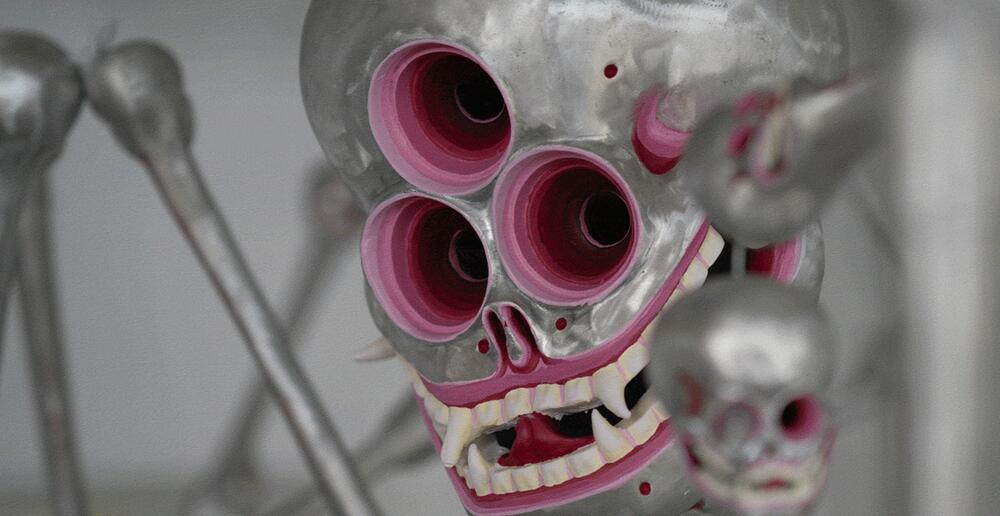
The exhibition Discovering the Present from the Future by Ochirbold Ayurzana in the Mongolian Pavilion explores the profound levels of consciousness through interactive sculpture installations. Inspired by the Buddhist deity Citipati, these sculptures, including the three-eyed skull, serve as reminders of the impermanence of life, fostering spiritual transformation and symbolizing the search for higher consciousness and enlightenment in Buddhism.
Citipati can embody the transition to the digital age as a guardian of technology. Another interpretation sees Citipati as a guardian of the environment, pointing to challenges such as climate change. Their movements illustrate the fragile balance between nature and humanity. In collective dances, they symbolize bridge-builders between cultures, embodying the idea of global interconnectedness in the North and South, and collaboration in an increasingly intercultural world.
Its artistic contribution delves into the exploration of profound levels of consciousness by analyzing societal and human behavioral shifts in the globalized world from various artistic perspectives. This exploration is facilitated through the new sculpture installation titled Discovering the Present from the Future, complemented by a depiction of the historic Citipati at the exhibition, and an ongoing series of sculpture installations titled Discovering Consciousness.
The exhibition staging at Arsenale Castello 2127A, Campa de la Tana opposite the main entrance to the Biennale at Arsenale, creates a captivating space of transformation. Through the interactive installation, visitors are actively engaged in exploring the “Stranger within Myself” theme and could interact and shape their own journeys of consciousness. By merging Buddhist wisdom with modern approaches, the artist aims to bridge the gap between the present and the future, providing thought-provoking insights and inspiring individuals to explore the present through the lens of the future.
-
Pavilion of MONGOLIA. Discovering the Present from the Future. 60th International Art Exhibition - La Biennale di Venezia. Photo: Andrea Avezzù. Courtesy: La Biennale di Venezia.
-
Pavilion of MONGOLIA. Discovering the Present from the Future. 60th International Art Exhibition - La Biennale di Venezia. Photo: Andrea Avezzù. Courtesy: La Biennale di Venezia.
-
Pavilion of MONGOLIA. Discovering the Present from the Future. 60th International Art Exhibition - La Biennale di Venezia. Photo: Andrea Avezzù. Courtesy: La Biennale di Venezia.
-
Pavilion of MONGOLIA. Discovering the Present from the Future. 60th International Art Exhibition - La Biennale di Venezia. Photo: Andrea Avezzù. Courtesy: La Biennale di Venezia.
-
Pavilion of MONGOLIA. Discovering the Present from the Future. 60th International Art Exhibition - La Biennale di Venezia. Photo: Andrea Avezzù. Courtesy: La Biennale di Venezia.
-
Pavilion of MONGOLIA. Discovering the Present from the Future. 60th International Art Exhibition - La Biennale di Venezia. Photo: Andrea Avezzù. Courtesy: La Biennale di Venezia.
-
Pavilion of MONGOLIA. Discovering the Present from the Future. 60th International Art Exhibition - La Biennale di Venezia. Photo: Andrea Avezzù. Courtesy: La Biennale di Venezia.
Ochirbold Ayurzana, born in 1976 in eastern Province of Mongolia, has been exploring societal and behavioral changes in the globalized world through his artistic concept of “Consciousness” since 2014. Questioning how consciousness evolves amid the deluge of information, he creates socially, and critically reflective works exhibited internationally, allowing individual interpretations by viewers. The artist emphasizes the importance of interactivity in his work. His sculptures provide viewers with the opportunity to discover hidden beauty despite critical ideas. The larger-than-life, gender-neutral figures representing “Consciousness” are in a meditative posture facing the spiraled center, metaphorically symbolizing the mental realm and the intermediate world. Crafted from delicate, oxidized steel wire mesh, the artwork conveys transcendence through its permeable construction. In particular, his concept of “Consciousness” reflects the desire for expanded awareness and a connection to the spiritual dimension.
May interest you
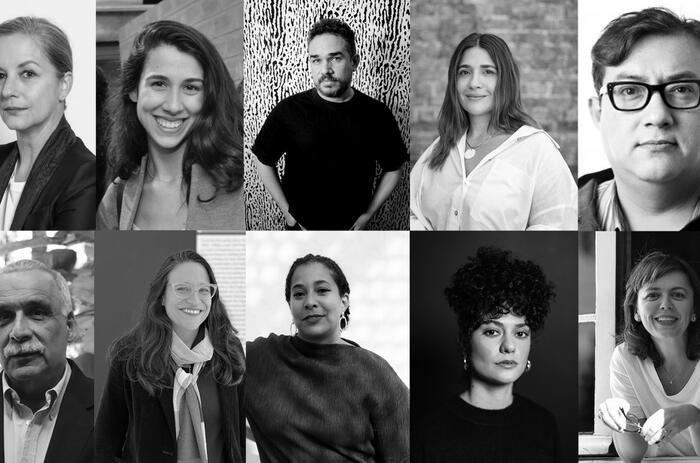
In the next edition of Pinta Sud | ASU 2024 -to be held from August 5 to 11, 2024 in Asuncion, Paraguay- the FORO lecture series will be one of the key spaces to delve into Latin American curatorial practice. Curated by Adriana Almada and Irene Gelfman, FORO will feature international guests such as Inés Katzenstein, Isabella Lenzi, Raphael Fonseca, among others.
LATIN AMERICAN CURATORIAL PRACTICE AT PINTA Sud | ASU 2024
In the next edition of Pinta Sud | ASU 2024 -to be held from August 5 to 11, 2024 in Asuncion, Paraguay- the FORO lecture series will be one of the key spaces to delve into Latin American curatorial practice. Curated by Adriana Almada and Irene Gelfman, FORO will feature international guests such as Inés Katzenstein, Isabella Lenzi, Raphael Fonseca, among others.

In the next edition of Pinta Sud | ASU 2024 -to be held from August 5 to 11, 2024 in Asuncion, Paraguay- the FORO lecture series will be one of the key spaces to delve into Latin American curatorial practice. Curated by Adriana Almada and Irene Gelfman, FORO will feature international guests such as Inés Katzenstein, Isabella Lenzi, Raphael Fonseca, among others.
LATIN AMERICAN CURATORIAL PRACTICE AT PINTA Sud | ASU 2024
In the next edition of Pinta Sud | ASU 2024 -to be held from August 5 to 11, 2024 in Asuncion, Paraguay- the FORO lecture series will be one of the key spaces to delve into Latin American curatorial practice. Curated by Adriana Almada and Irene Gelfman, FORO will feature international guests such as Inés Katzenstein, Isabella Lenzi, Raphael Fonseca, among others.
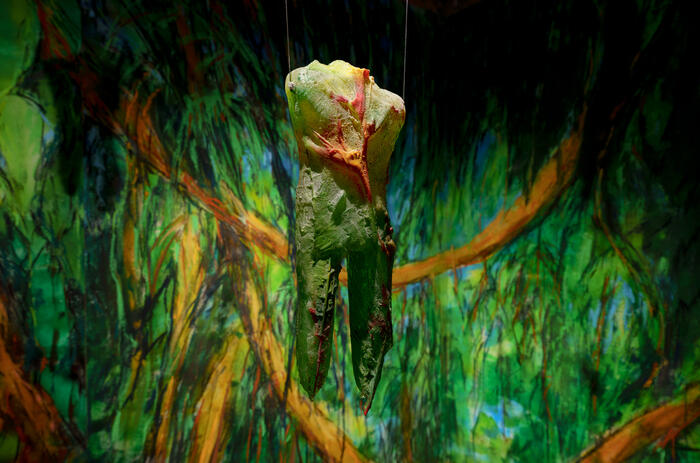
The Panama Pavilion at the 2024 Venice Art Biennale arises as a profound reflection on the enduring traces that migration leaves on individuals and their surroundings. Entitled Traces: On the Body and on the Land, this exhibition echoes the current migration crisis with a particular focus on the Panamanian context, interpreted by four artists through drawings, paintings, collages, glass sculptures, and installations.
TRACES – PANAMÁ’S DEBUT AT THE VENICE BIENNALE
The Panama Pavilion at the 2024 Venice Art Biennale arises as a profound reflection on the enduring traces that migration leaves on individuals and their surroundings. Entitled Traces: On the Body and on the Land, this exhibition echoes the current migration crisis with a particular focus on the Panamanian context, interpreted by four artists through drawings, paintings, collages, glass sculptures, and installations.
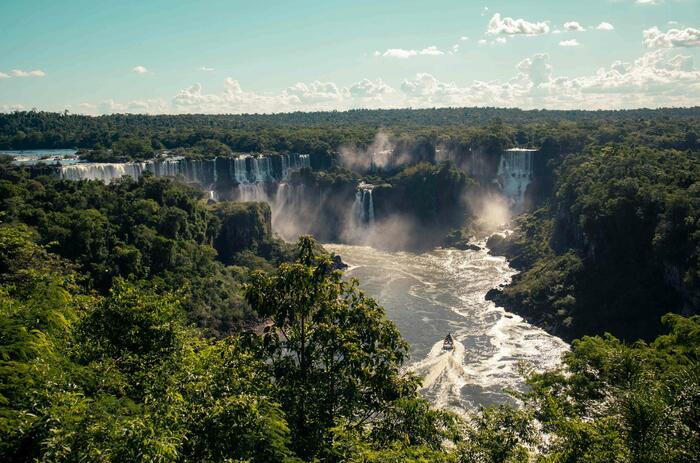
The next Pompidou Museum project in Foz do Iguaçu will be presented by Luciana Pereira, Secretary of Culture of the State of Paraná, Brazil, at the Pinta Sud | ASU conference, to be held at the Casa de la Integración (CAF) on August 8, 2024. This will be the first Pompidou Center in Latin America.
THE POMPIDOU MUSEUM PROJECT IN FOZ DO IGUAZU WILL BE PRESENTED AT PINTA Sud | ASU 2024
The next Pompidou Museum project in Foz do Iguaçu will be presented by Luciana Pereira, Secretary of Culture of the State of Paraná, Brazil, at the Pinta Sud | ASU conference, to be held at the Casa de la Integración (CAF) on August 8, 2024. This will be the first Pompidou Center in Latin America.
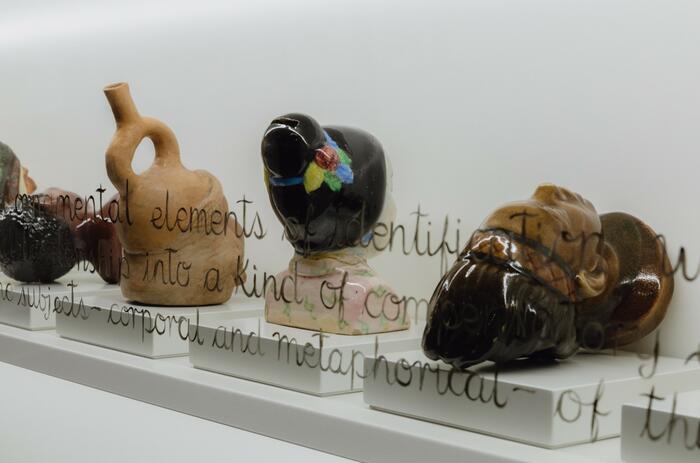
Spanish-Peruvian artist Sandra Gamarra Heshiki represents Spain at the Venice Biennale. It is the first time in 60 editions that an artist not born in Spain does so. Her project Pinacoteca migrante (Migrant gallery), questions colonial narratives and historical modes of representation.
PINACOTECA MIGRANTE: SPAIN AT THE VENICE BIENNALE
Spanish-Peruvian artist Sandra Gamarra Heshiki represents Spain at the Venice Biennale. It is the first time in 60 editions that an artist not born in Spain does so. Her project Pinacoteca migrante (Migrant gallery), questions colonial narratives and historical modes of representation.
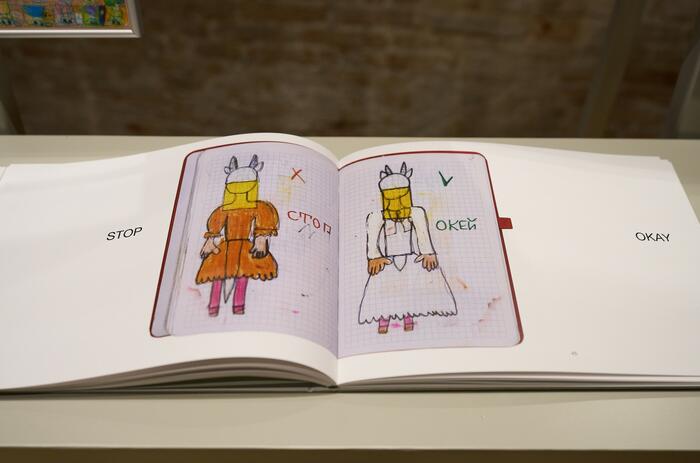
The Ukranian Pavilion addresses the othering effect of war, two years into the Russian Invasion, in Net Making at the 60th Venice Biennale.
UKRAINE AND THE EFECT OF WAR AT VENICE BIENNALE
The Ukranian Pavilion addresses the othering effect of war, two years into the Russian Invasion, in Net Making at the 60th Venice Biennale.
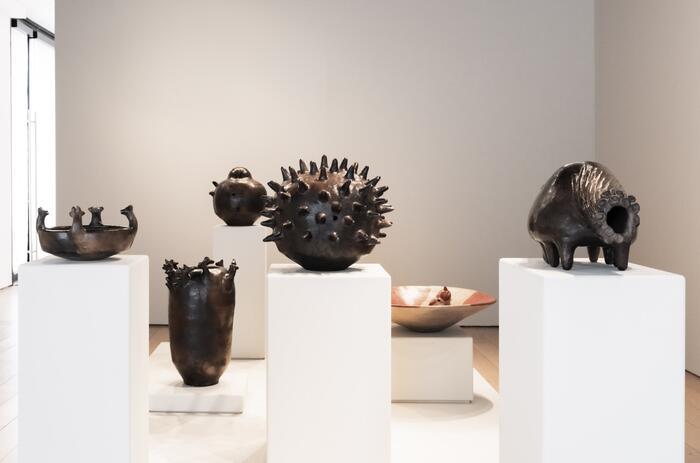
Kasmin gallery presented Mundo de Julia, an exhibition of ceramic sculpture by Julia Isídrez. This is the artist’s first solo exhibition in the United States and runs concurrently with Isídrez’s presentation in Stranieri Ovunque – Foreigners Everywhere, the 60th International Art Exhibition of La Biennale di Venezia curated by Adriano Pedrosa.
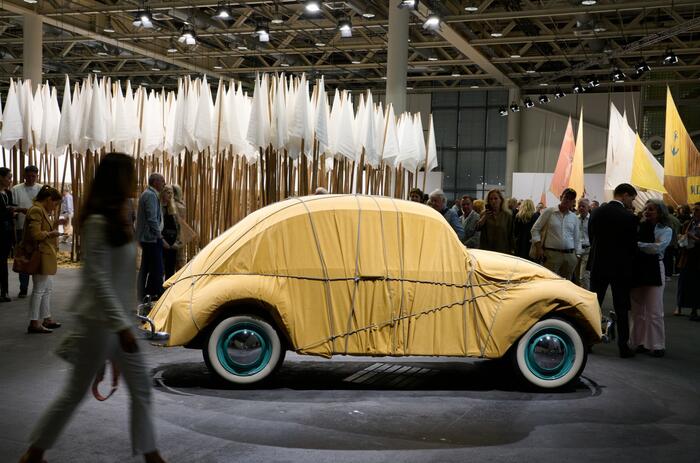
The Art Basel in Basel fair concluded on June 16th, signaling the near end of the market season before summer. Despite the June London auctions (featuring works from antiquity to contemporary art) this year’s London season is notably diminished.
ART BASEL IN BASEL 2024: A FAIR FOR EVERY BUDGET?
The Art Basel in Basel fair concluded on June 16th, signaling the near end of the market season before summer. Despite the June London auctions (featuring works from antiquity to contemporary art) this year’s London season is notably diminished.
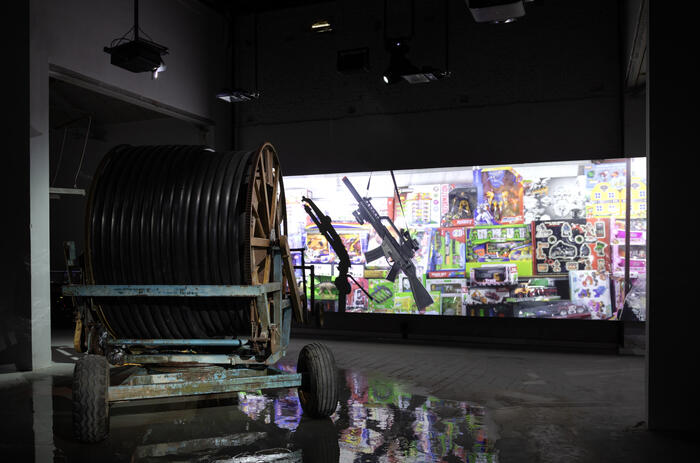
Xirómero / Dryland is an interdisciplinary collective work conceived by Thanasis Deligiannis and Yannis Michalopoulos, created along with the artists Elia Kalogianni, Yorgos Kyvernitis, Kostas Chaikalis and Fotis Sagonas for the Greek Pavilion at the 60th Venice Biennale. The project is curated by Panos Giannikopoulos.
WATER AS A PRISM: GREEK PAVILION AT THE VENICE BIENNALE
Xirómero / Dryland is an interdisciplinary collective work conceived by Thanasis Deligiannis and Yannis Michalopoulos, created along with the artists Elia Kalogianni, Yorgos Kyvernitis, Kostas Chaikalis and Fotis Sagonas for the Greek Pavilion at the 60th Venice Biennale. The project is curated by Panos Giannikopoulos.
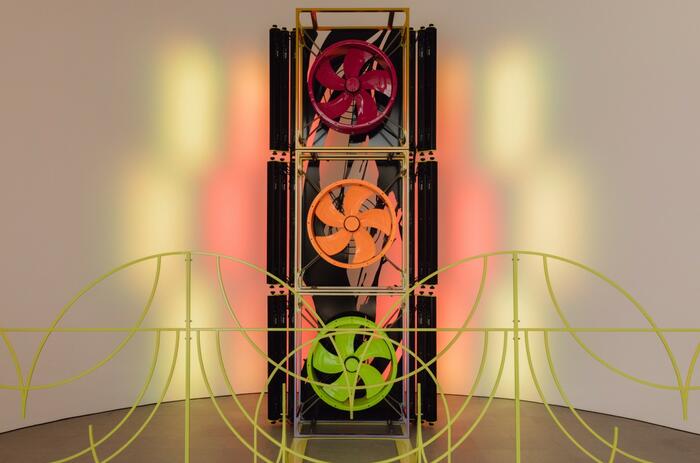
For the 60th International Venice Biennale, Nemes designed the project as an immersive, painting-based Gesamtkunstwerk that expands the genre of painting and extends it to other media. Project curated by Róna Kopeczky.
TECHNO ZEN BY MÁRTON NEMEZ: THE HUNGARIAN PAVILION IN VENICE BIENNALE
For the 60th International Venice Biennale, Nemes designed the project as an immersive, painting-based Gesamtkunstwerk that expands the genre of painting and extends it to other media. Project curated by Róna Kopeczky.
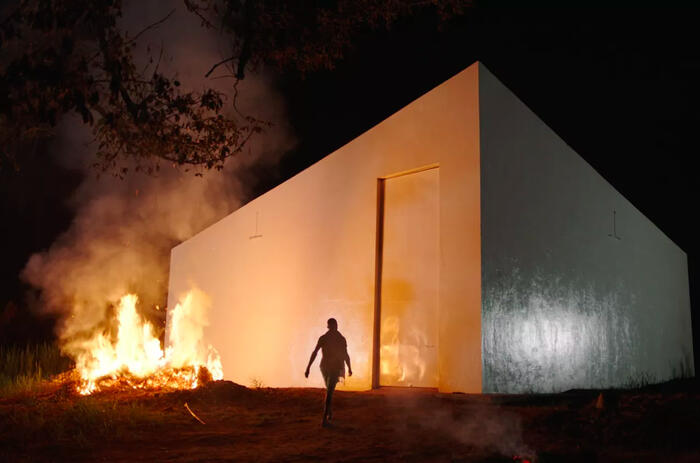
The title of the 60th International Art Exhibition of the Biennale di Venezia, "Stranieri Ovunque", refers, in part, to foreignness as the inherent nature of the subject. Understood in this way, the national pavilions of Spain, the Netherlands and the United Kingdom exhibit artistic proposals that develop the theme of colonialism and reconstruct histories, remedy ties between identity and territory, and explore the dramatic plurality of this potent historical axis. That said, this review does not intend to unveil or unpack the most unjust transcendental truths, but merely to reflect on the musings of others.
THREE PAVILIONS AT BIENNALE 2024 THAT EXPLORE THEIR OWN COLONIAL PASTS
The title of the 60th International Art Exhibition of the Biennale di Venezia, "Stranieri Ovunque", refers, in part, to foreignness as the inherent nature of the subject. Understood in this way, the national pavilions of Spain, the Netherlands and the United Kingdom exhibit artistic proposals that develop the theme of colonialism and reconstruct histories, remedy ties between identity and territory, and explore the dramatic plurality of this potent historical axis. That said, this review does not intend to unveil or unpack the most unjust transcendental truths, but merely to reflect on the musings of others.
It takes an Island to Feel this Good is Darja Bajagić’s exhibition for the Montenegro pavilion at Venice Biennale 2024. Curated by Ana Simona Zelenović and organized by the Museum of Contemporary Art of Montenegro at the initiative of commissioner Vladislav Šćepanović, the exhibition will present a critical consideration of the culture of collective memory and the relationship to shared historical heritage.
ICONOGRAPHY, MEMORY AND HISTORY - THE MONTENEGRO PAVILION
It takes an Island to Feel this Good is Darja Bajagić’s exhibition for the Montenegro pavilion at Venice Biennale 2024. Curated by Ana Simona Zelenović and organized by the Museum of Contemporary Art of Montenegro at the initiative of commissioner Vladislav Šćepanović, the exhibition will present a critical consideration of the culture of collective memory and the relationship to shared historical heritage.
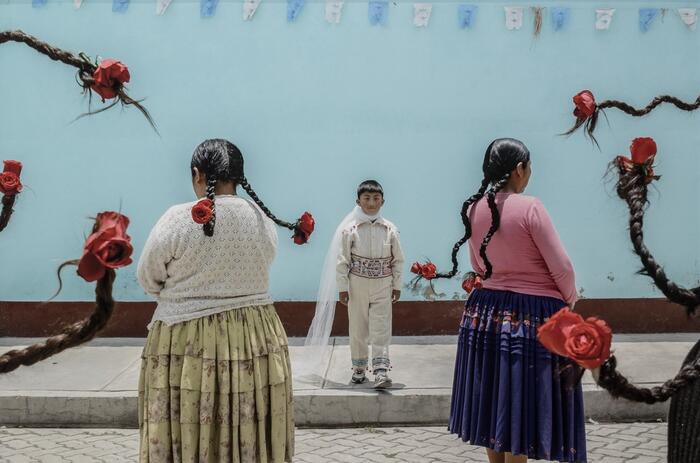
Why highlight stories that often remain on the periphery of artistic discourse? Adriano Pedrosa justifies his curatorial decision with works by 331 artists -mostly from the global south- that open the way to powerful narratives. Finally, we see the axis being twisted. It is difficult to escape the white gaze, more so to move authentically through a Eurocentric space. Given this, the communicative reach of figuration serves to challenge the symbolic order of domination and destabilize the colonial project. The stories that are made explicit and the narratives of magic and everyday life help to recognize without revictimizing.
STORIES FROM THE SOUTH – THE VENICE BIENNALE TURNS AROUND ITS AXIS
Why highlight stories that often remain on the periphery of artistic discourse? Adriano Pedrosa justifies his curatorial decision with works by 331 artists -mostly from the global south- that open the way to powerful narratives. Finally, we see the axis being twisted. It is difficult to escape the white gaze, more so to move authentically through a Eurocentric space. Given this, the communicative reach of figuration serves to challenge the symbolic order of domination and destabilize the colonial project. The stories that are made explicit and the narratives of magic and everyday life help to recognize without revictimizing.
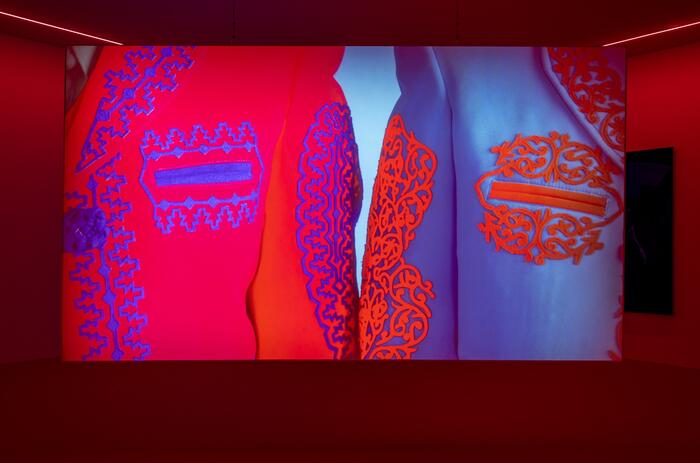
The voices of Latin American artists emerge strongly in this 2024 edition of the Venice Biennale. Claudia Alarcón, Julia Isídrez and Juana Marta Rodas, Ana Segovia, Frieda Toranzo Jaeger and Claudia Andújar lead viewers on a profound journey through their cultural heritage and unique artistic practices.
FIVE LATIN AMERICAN ARTISTS EXHIBITING FOR THE FIRST TIME AT THE VENICE BIENNALE
The voices of Latin American artists emerge strongly in this 2024 edition of the Venice Biennale. Claudia Alarcón, Julia Isídrez and Juana Marta Rodas, Ana Segovia, Frieda Toranzo Jaeger and Claudia Andújar lead viewers on a profound journey through their cultural heritage and unique artistic practices.

In the next edition of Pinta Sud | ASU 2024 -to be held from August 5 to 11, 2024 in Asuncion, Paraguay- the FORO lecture series will be one of the key spaces to delve into Latin American curatorial practice. Curated by Adriana Almada and Irene Gelfman, FORO will feature international guests such as Inés Katzenstein, Isabella Lenzi, Raphael Fonseca, among others.
LATIN AMERICAN CURATORIAL PRACTICE AT PINTA Sud | ASU 2024
In the next edition of Pinta Sud | ASU 2024 -to be held from August 5 to 11, 2024 in Asuncion, Paraguay- the FORO lecture series will be one of the key spaces to delve into Latin American curatorial practice. Curated by Adriana Almada and Irene Gelfman, FORO will feature international guests such as Inés Katzenstein, Isabella Lenzi, Raphael Fonseca, among others.

The Panama Pavilion at the 2024 Venice Art Biennale arises as a profound reflection on the enduring traces that migration leaves on individuals and their surroundings. Entitled Traces: On the Body and on the Land, this exhibition echoes the current migration crisis with a particular focus on the Panamanian context, interpreted by four artists through drawings, paintings, collages, glass sculptures, and installations.
TRACES – PANAMÁ’S DEBUT AT THE VENICE BIENNALE
The Panama Pavilion at the 2024 Venice Art Biennale arises as a profound reflection on the enduring traces that migration leaves on individuals and their surroundings. Entitled Traces: On the Body and on the Land, this exhibition echoes the current migration crisis with a particular focus on the Panamanian context, interpreted by four artists through drawings, paintings, collages, glass sculptures, and installations.

The next Pompidou Museum project in Foz do Iguaçu will be presented by Luciana Pereira, Secretary of Culture of the State of Paraná, Brazil, at the Pinta Sud | ASU conference, to be held at the Casa de la Integración (CAF) on August 8, 2024. This will be the first Pompidou Center in Latin America.
THE POMPIDOU MUSEUM PROJECT IN FOZ DO IGUAZU WILL BE PRESENTED AT PINTA Sud | ASU 2024
The next Pompidou Museum project in Foz do Iguaçu will be presented by Luciana Pereira, Secretary of Culture of the State of Paraná, Brazil, at the Pinta Sud | ASU conference, to be held at the Casa de la Integración (CAF) on August 8, 2024. This will be the first Pompidou Center in Latin America.

Spanish-Peruvian artist Sandra Gamarra Heshiki represents Spain at the Venice Biennale. It is the first time in 60 editions that an artist not born in Spain does so. Her project Pinacoteca migrante (Migrant gallery), questions colonial narratives and historical modes of representation.
PINACOTECA MIGRANTE: SPAIN AT THE VENICE BIENNALE
Spanish-Peruvian artist Sandra Gamarra Heshiki represents Spain at the Venice Biennale. It is the first time in 60 editions that an artist not born in Spain does so. Her project Pinacoteca migrante (Migrant gallery), questions colonial narratives and historical modes of representation.

The Ukranian Pavilion addresses the othering effect of war, two years into the Russian Invasion, in Net Making at the 60th Venice Biennale.
UKRAINE AND THE EFECT OF WAR AT VENICE BIENNALE
The Ukranian Pavilion addresses the othering effect of war, two years into the Russian Invasion, in Net Making at the 60th Venice Biennale.

Kasmin gallery presented Mundo de Julia, an exhibition of ceramic sculpture by Julia Isídrez. This is the artist’s first solo exhibition in the United States and runs concurrently with Isídrez’s presentation in Stranieri Ovunque – Foreigners Everywhere, the 60th International Art Exhibition of La Biennale di Venezia curated by Adriano Pedrosa.

The Art Basel in Basel fair concluded on June 16th, signaling the near end of the market season before summer. Despite the June London auctions (featuring works from antiquity to contemporary art) this year’s London season is notably diminished.
ART BASEL IN BASEL 2024: A FAIR FOR EVERY BUDGET?
The Art Basel in Basel fair concluded on June 16th, signaling the near end of the market season before summer. Despite the June London auctions (featuring works from antiquity to contemporary art) this year’s London season is notably diminished.

Xirómero / Dryland is an interdisciplinary collective work conceived by Thanasis Deligiannis and Yannis Michalopoulos, created along with the artists Elia Kalogianni, Yorgos Kyvernitis, Kostas Chaikalis and Fotis Sagonas for the Greek Pavilion at the 60th Venice Biennale. The project is curated by Panos Giannikopoulos.
WATER AS A PRISM: GREEK PAVILION AT THE VENICE BIENNALE
Xirómero / Dryland is an interdisciplinary collective work conceived by Thanasis Deligiannis and Yannis Michalopoulos, created along with the artists Elia Kalogianni, Yorgos Kyvernitis, Kostas Chaikalis and Fotis Sagonas for the Greek Pavilion at the 60th Venice Biennale. The project is curated by Panos Giannikopoulos.

For the 60th International Venice Biennale, Nemes designed the project as an immersive, painting-based Gesamtkunstwerk that expands the genre of painting and extends it to other media. Project curated by Róna Kopeczky.
TECHNO ZEN BY MÁRTON NEMEZ: THE HUNGARIAN PAVILION IN VENICE BIENNALE
For the 60th International Venice Biennale, Nemes designed the project as an immersive, painting-based Gesamtkunstwerk that expands the genre of painting and extends it to other media. Project curated by Róna Kopeczky.

The title of the 60th International Art Exhibition of the Biennale di Venezia, "Stranieri Ovunque", refers, in part, to foreignness as the inherent nature of the subject. Understood in this way, the national pavilions of Spain, the Netherlands and the United Kingdom exhibit artistic proposals that develop the theme of colonialism and reconstruct histories, remedy ties between identity and territory, and explore the dramatic plurality of this potent historical axis. That said, this review does not intend to unveil or unpack the most unjust transcendental truths, but merely to reflect on the musings of others.
THREE PAVILIONS AT BIENNALE 2024 THAT EXPLORE THEIR OWN COLONIAL PASTS
The title of the 60th International Art Exhibition of the Biennale di Venezia, "Stranieri Ovunque", refers, in part, to foreignness as the inherent nature of the subject. Understood in this way, the national pavilions of Spain, the Netherlands and the United Kingdom exhibit artistic proposals that develop the theme of colonialism and reconstruct histories, remedy ties between identity and territory, and explore the dramatic plurality of this potent historical axis. That said, this review does not intend to unveil or unpack the most unjust transcendental truths, but merely to reflect on the musings of others.
It takes an Island to Feel this Good is Darja Bajagić’s exhibition for the Montenegro pavilion at Venice Biennale 2024. Curated by Ana Simona Zelenović and organized by the Museum of Contemporary Art of Montenegro at the initiative of commissioner Vladislav Šćepanović, the exhibition will present a critical consideration of the culture of collective memory and the relationship to shared historical heritage.
ICONOGRAPHY, MEMORY AND HISTORY - THE MONTENEGRO PAVILION
It takes an Island to Feel this Good is Darja Bajagić’s exhibition for the Montenegro pavilion at Venice Biennale 2024. Curated by Ana Simona Zelenović and organized by the Museum of Contemporary Art of Montenegro at the initiative of commissioner Vladislav Šćepanović, the exhibition will present a critical consideration of the culture of collective memory and the relationship to shared historical heritage.

Why highlight stories that often remain on the periphery of artistic discourse? Adriano Pedrosa justifies his curatorial decision with works by 331 artists -mostly from the global south- that open the way to powerful narratives. Finally, we see the axis being twisted. It is difficult to escape the white gaze, more so to move authentically through a Eurocentric space. Given this, the communicative reach of figuration serves to challenge the symbolic order of domination and destabilize the colonial project. The stories that are made explicit and the narratives of magic and everyday life help to recognize without revictimizing.
STORIES FROM THE SOUTH – THE VENICE BIENNALE TURNS AROUND ITS AXIS
Why highlight stories that often remain on the periphery of artistic discourse? Adriano Pedrosa justifies his curatorial decision with works by 331 artists -mostly from the global south- that open the way to powerful narratives. Finally, we see the axis being twisted. It is difficult to escape the white gaze, more so to move authentically through a Eurocentric space. Given this, the communicative reach of figuration serves to challenge the symbolic order of domination and destabilize the colonial project. The stories that are made explicit and the narratives of magic and everyday life help to recognize without revictimizing.

The voices of Latin American artists emerge strongly in this 2024 edition of the Venice Biennale. Claudia Alarcón, Julia Isídrez and Juana Marta Rodas, Ana Segovia, Frieda Toranzo Jaeger and Claudia Andújar lead viewers on a profound journey through their cultural heritage and unique artistic practices.
FIVE LATIN AMERICAN ARTISTS EXHIBITING FOR THE FIRST TIME AT THE VENICE BIENNALE
The voices of Latin American artists emerge strongly in this 2024 edition of the Venice Biennale. Claudia Alarcón, Julia Isídrez and Juana Marta Rodas, Ana Segovia, Frieda Toranzo Jaeger and Claudia Andújar lead viewers on a profound journey through their cultural heritage and unique artistic practices.

In the next edition of Pinta Sud | ASU 2024 -to be held from August 5 to 11, 2024 in Asuncion, Paraguay- the FORO lecture series will be one of the key spaces to delve into Latin American curatorial practice. Curated by Adriana Almada and Irene Gelfman, FORO will feature international guests such as Inés Katzenstein, Isabella Lenzi, Raphael Fonseca, among others.
LATIN AMERICAN CURATORIAL PRACTICE AT PINTA Sud | ASU 2024
In the next edition of Pinta Sud | ASU 2024 -to be held from August 5 to 11, 2024 in Asuncion, Paraguay- the FORO lecture series will be one of the key spaces to delve into Latin American curatorial practice. Curated by Adriana Almada and Irene Gelfman, FORO will feature international guests such as Inés Katzenstein, Isabella Lenzi, Raphael Fonseca, among others.

The Panama Pavilion at the 2024 Venice Art Biennale arises as a profound reflection on the enduring traces that migration leaves on individuals and their surroundings. Entitled Traces: On the Body and on the Land, this exhibition echoes the current migration crisis with a particular focus on the Panamanian context, interpreted by four artists through drawings, paintings, collages, glass sculptures, and installations.
TRACES – PANAMÁ’S DEBUT AT THE VENICE BIENNALE
The Panama Pavilion at the 2024 Venice Art Biennale arises as a profound reflection on the enduring traces that migration leaves on individuals and their surroundings. Entitled Traces: On the Body and on the Land, this exhibition echoes the current migration crisis with a particular focus on the Panamanian context, interpreted by four artists through drawings, paintings, collages, glass sculptures, and installations.

The next Pompidou Museum project in Foz do Iguaçu will be presented by Luciana Pereira, Secretary of Culture of the State of Paraná, Brazil, at the Pinta Sud | ASU conference, to be held at the Casa de la Integración (CAF) on August 8, 2024. This will be the first Pompidou Center in Latin America.
THE POMPIDOU MUSEUM PROJECT IN FOZ DO IGUAZU WILL BE PRESENTED AT PINTA Sud | ASU 2024
The next Pompidou Museum project in Foz do Iguaçu will be presented by Luciana Pereira, Secretary of Culture of the State of Paraná, Brazil, at the Pinta Sud | ASU conference, to be held at the Casa de la Integración (CAF) on August 8, 2024. This will be the first Pompidou Center in Latin America.

Spanish-Peruvian artist Sandra Gamarra Heshiki represents Spain at the Venice Biennale. It is the first time in 60 editions that an artist not born in Spain does so. Her project Pinacoteca migrante (Migrant gallery), questions colonial narratives and historical modes of representation.
PINACOTECA MIGRANTE: SPAIN AT THE VENICE BIENNALE
Spanish-Peruvian artist Sandra Gamarra Heshiki represents Spain at the Venice Biennale. It is the first time in 60 editions that an artist not born in Spain does so. Her project Pinacoteca migrante (Migrant gallery), questions colonial narratives and historical modes of representation.

The Ukranian Pavilion addresses the othering effect of war, two years into the Russian Invasion, in Net Making at the 60th Venice Biennale.
UKRAINE AND THE EFECT OF WAR AT VENICE BIENNALE
The Ukranian Pavilion addresses the othering effect of war, two years into the Russian Invasion, in Net Making at the 60th Venice Biennale.

Kasmin gallery presented Mundo de Julia, an exhibition of ceramic sculpture by Julia Isídrez. This is the artist’s first solo exhibition in the United States and runs concurrently with Isídrez’s presentation in Stranieri Ovunque – Foreigners Everywhere, the 60th International Art Exhibition of La Biennale di Venezia curated by Adriano Pedrosa.

The Art Basel in Basel fair concluded on June 16th, signaling the near end of the market season before summer. Despite the June London auctions (featuring works from antiquity to contemporary art) this year’s London season is notably diminished.
ART BASEL IN BASEL 2024: A FAIR FOR EVERY BUDGET?
The Art Basel in Basel fair concluded on June 16th, signaling the near end of the market season before summer. Despite the June London auctions (featuring works from antiquity to contemporary art) this year’s London season is notably diminished.

Xirómero / Dryland is an interdisciplinary collective work conceived by Thanasis Deligiannis and Yannis Michalopoulos, created along with the artists Elia Kalogianni, Yorgos Kyvernitis, Kostas Chaikalis and Fotis Sagonas for the Greek Pavilion at the 60th Venice Biennale. The project is curated by Panos Giannikopoulos.
WATER AS A PRISM: GREEK PAVILION AT THE VENICE BIENNALE
Xirómero / Dryland is an interdisciplinary collective work conceived by Thanasis Deligiannis and Yannis Michalopoulos, created along with the artists Elia Kalogianni, Yorgos Kyvernitis, Kostas Chaikalis and Fotis Sagonas for the Greek Pavilion at the 60th Venice Biennale. The project is curated by Panos Giannikopoulos.

For the 60th International Venice Biennale, Nemes designed the project as an immersive, painting-based Gesamtkunstwerk that expands the genre of painting and extends it to other media. Project curated by Róna Kopeczky.
TECHNO ZEN BY MÁRTON NEMEZ: THE HUNGARIAN PAVILION IN VENICE BIENNALE
For the 60th International Venice Biennale, Nemes designed the project as an immersive, painting-based Gesamtkunstwerk that expands the genre of painting and extends it to other media. Project curated by Róna Kopeczky.

The title of the 60th International Art Exhibition of the Biennale di Venezia, "Stranieri Ovunque", refers, in part, to foreignness as the inherent nature of the subject. Understood in this way, the national pavilions of Spain, the Netherlands and the United Kingdom exhibit artistic proposals that develop the theme of colonialism and reconstruct histories, remedy ties between identity and territory, and explore the dramatic plurality of this potent historical axis. That said, this review does not intend to unveil or unpack the most unjust transcendental truths, but merely to reflect on the musings of others.
THREE PAVILIONS AT BIENNALE 2024 THAT EXPLORE THEIR OWN COLONIAL PASTS
The title of the 60th International Art Exhibition of the Biennale di Venezia, "Stranieri Ovunque", refers, in part, to foreignness as the inherent nature of the subject. Understood in this way, the national pavilions of Spain, the Netherlands and the United Kingdom exhibit artistic proposals that develop the theme of colonialism and reconstruct histories, remedy ties between identity and territory, and explore the dramatic plurality of this potent historical axis. That said, this review does not intend to unveil or unpack the most unjust transcendental truths, but merely to reflect on the musings of others.
It takes an Island to Feel this Good is Darja Bajagić’s exhibition for the Montenegro pavilion at Venice Biennale 2024. Curated by Ana Simona Zelenović and organized by the Museum of Contemporary Art of Montenegro at the initiative of commissioner Vladislav Šćepanović, the exhibition will present a critical consideration of the culture of collective memory and the relationship to shared historical heritage.
ICONOGRAPHY, MEMORY AND HISTORY - THE MONTENEGRO PAVILION
It takes an Island to Feel this Good is Darja Bajagić’s exhibition for the Montenegro pavilion at Venice Biennale 2024. Curated by Ana Simona Zelenović and organized by the Museum of Contemporary Art of Montenegro at the initiative of commissioner Vladislav Šćepanović, the exhibition will present a critical consideration of the culture of collective memory and the relationship to shared historical heritage.

Why highlight stories that often remain on the periphery of artistic discourse? Adriano Pedrosa justifies his curatorial decision with works by 331 artists -mostly from the global south- that open the way to powerful narratives. Finally, we see the axis being twisted. It is difficult to escape the white gaze, more so to move authentically through a Eurocentric space. Given this, the communicative reach of figuration serves to challenge the symbolic order of domination and destabilize the colonial project. The stories that are made explicit and the narratives of magic and everyday life help to recognize without revictimizing.
STORIES FROM THE SOUTH – THE VENICE BIENNALE TURNS AROUND ITS AXIS
Why highlight stories that often remain on the periphery of artistic discourse? Adriano Pedrosa justifies his curatorial decision with works by 331 artists -mostly from the global south- that open the way to powerful narratives. Finally, we see the axis being twisted. It is difficult to escape the white gaze, more so to move authentically through a Eurocentric space. Given this, the communicative reach of figuration serves to challenge the symbolic order of domination and destabilize the colonial project. The stories that are made explicit and the narratives of magic and everyday life help to recognize without revictimizing.

The voices of Latin American artists emerge strongly in this 2024 edition of the Venice Biennale. Claudia Alarcón, Julia Isídrez and Juana Marta Rodas, Ana Segovia, Frieda Toranzo Jaeger and Claudia Andújar lead viewers on a profound journey through their cultural heritage and unique artistic practices.
FIVE LATIN AMERICAN ARTISTS EXHIBITING FOR THE FIRST TIME AT THE VENICE BIENNALE
The voices of Latin American artists emerge strongly in this 2024 edition of the Venice Biennale. Claudia Alarcón, Julia Isídrez and Juana Marta Rodas, Ana Segovia, Frieda Toranzo Jaeger and Claudia Andújar lead viewers on a profound journey through their cultural heritage and unique artistic practices.

In the next edition of Pinta Sud | ASU 2024 -to be held from August 5 to 11, 2024 in Asuncion, Paraguay- the FORO lecture series will be one of the key spaces to delve into Latin American curatorial practice. Curated by Adriana Almada and Irene Gelfman, FORO will feature international guests such as Inés Katzenstein, Isabella Lenzi, Raphael Fonseca, among others.
LATIN AMERICAN CURATORIAL PRACTICE AT PINTA Sud | ASU 2024
In the next edition of Pinta Sud | ASU 2024 -to be held from August 5 to 11, 2024 in Asuncion, Paraguay- the FORO lecture series will be one of the key spaces to delve into Latin American curatorial practice. Curated by Adriana Almada and Irene Gelfman, FORO will feature international guests such as Inés Katzenstein, Isabella Lenzi, Raphael Fonseca, among others.

The Panama Pavilion at the 2024 Venice Art Biennale arises as a profound reflection on the enduring traces that migration leaves on individuals and their surroundings. Entitled Traces: On the Body and on the Land, this exhibition echoes the current migration crisis with a particular focus on the Panamanian context, interpreted by four artists through drawings, paintings, collages, glass sculptures, and installations.
TRACES – PANAMÁ’S DEBUT AT THE VENICE BIENNALE
The Panama Pavilion at the 2024 Venice Art Biennale arises as a profound reflection on the enduring traces that migration leaves on individuals and their surroundings. Entitled Traces: On the Body and on the Land, this exhibition echoes the current migration crisis with a particular focus on the Panamanian context, interpreted by four artists through drawings, paintings, collages, glass sculptures, and installations.

The next Pompidou Museum project in Foz do Iguaçu will be presented by Luciana Pereira, Secretary of Culture of the State of Paraná, Brazil, at the Pinta Sud | ASU conference, to be held at the Casa de la Integración (CAF) on August 8, 2024. This will be the first Pompidou Center in Latin America.
THE POMPIDOU MUSEUM PROJECT IN FOZ DO IGUAZU WILL BE PRESENTED AT PINTA Sud | ASU 2024
The next Pompidou Museum project in Foz do Iguaçu will be presented by Luciana Pereira, Secretary of Culture of the State of Paraná, Brazil, at the Pinta Sud | ASU conference, to be held at the Casa de la Integración (CAF) on August 8, 2024. This will be the first Pompidou Center in Latin America.

Spanish-Peruvian artist Sandra Gamarra Heshiki represents Spain at the Venice Biennale. It is the first time in 60 editions that an artist not born in Spain does so. Her project Pinacoteca migrante (Migrant gallery), questions colonial narratives and historical modes of representation.
PINACOTECA MIGRANTE: SPAIN AT THE VENICE BIENNALE
Spanish-Peruvian artist Sandra Gamarra Heshiki represents Spain at the Venice Biennale. It is the first time in 60 editions that an artist not born in Spain does so. Her project Pinacoteca migrante (Migrant gallery), questions colonial narratives and historical modes of representation.

The Ukranian Pavilion addresses the othering effect of war, two years into the Russian Invasion, in Net Making at the 60th Venice Biennale.
UKRAINE AND THE EFECT OF WAR AT VENICE BIENNALE
The Ukranian Pavilion addresses the othering effect of war, two years into the Russian Invasion, in Net Making at the 60th Venice Biennale.

Kasmin gallery presented Mundo de Julia, an exhibition of ceramic sculpture by Julia Isídrez. This is the artist’s first solo exhibition in the United States and runs concurrently with Isídrez’s presentation in Stranieri Ovunque – Foreigners Everywhere, the 60th International Art Exhibition of La Biennale di Venezia curated by Adriano Pedrosa.

The Art Basel in Basel fair concluded on June 16th, signaling the near end of the market season before summer. Despite the June London auctions (featuring works from antiquity to contemporary art) this year’s London season is notably diminished.
ART BASEL IN BASEL 2024: A FAIR FOR EVERY BUDGET?
The Art Basel in Basel fair concluded on June 16th, signaling the near end of the market season before summer. Despite the June London auctions (featuring works from antiquity to contemporary art) this year’s London season is notably diminished.

Xirómero / Dryland is an interdisciplinary collective work conceived by Thanasis Deligiannis and Yannis Michalopoulos, created along with the artists Elia Kalogianni, Yorgos Kyvernitis, Kostas Chaikalis and Fotis Sagonas for the Greek Pavilion at the 60th Venice Biennale. The project is curated by Panos Giannikopoulos.
WATER AS A PRISM: GREEK PAVILION AT THE VENICE BIENNALE
Xirómero / Dryland is an interdisciplinary collective work conceived by Thanasis Deligiannis and Yannis Michalopoulos, created along with the artists Elia Kalogianni, Yorgos Kyvernitis, Kostas Chaikalis and Fotis Sagonas for the Greek Pavilion at the 60th Venice Biennale. The project is curated by Panos Giannikopoulos.

For the 60th International Venice Biennale, Nemes designed the project as an immersive, painting-based Gesamtkunstwerk that expands the genre of painting and extends it to other media. Project curated by Róna Kopeczky.
TECHNO ZEN BY MÁRTON NEMEZ: THE HUNGARIAN PAVILION IN VENICE BIENNALE
For the 60th International Venice Biennale, Nemes designed the project as an immersive, painting-based Gesamtkunstwerk that expands the genre of painting and extends it to other media. Project curated by Róna Kopeczky.

The title of the 60th International Art Exhibition of the Biennale di Venezia, "Stranieri Ovunque", refers, in part, to foreignness as the inherent nature of the subject. Understood in this way, the national pavilions of Spain, the Netherlands and the United Kingdom exhibit artistic proposals that develop the theme of colonialism and reconstruct histories, remedy ties between identity and territory, and explore the dramatic plurality of this potent historical axis. That said, this review does not intend to unveil or unpack the most unjust transcendental truths, but merely to reflect on the musings of others.
THREE PAVILIONS AT BIENNALE 2024 THAT EXPLORE THEIR OWN COLONIAL PASTS
The title of the 60th International Art Exhibition of the Biennale di Venezia, "Stranieri Ovunque", refers, in part, to foreignness as the inherent nature of the subject. Understood in this way, the national pavilions of Spain, the Netherlands and the United Kingdom exhibit artistic proposals that develop the theme of colonialism and reconstruct histories, remedy ties between identity and territory, and explore the dramatic plurality of this potent historical axis. That said, this review does not intend to unveil or unpack the most unjust transcendental truths, but merely to reflect on the musings of others.
It takes an Island to Feel this Good is Darja Bajagić’s exhibition for the Montenegro pavilion at Venice Biennale 2024. Curated by Ana Simona Zelenović and organized by the Museum of Contemporary Art of Montenegro at the initiative of commissioner Vladislav Šćepanović, the exhibition will present a critical consideration of the culture of collective memory and the relationship to shared historical heritage.
ICONOGRAPHY, MEMORY AND HISTORY - THE MONTENEGRO PAVILION
It takes an Island to Feel this Good is Darja Bajagić’s exhibition for the Montenegro pavilion at Venice Biennale 2024. Curated by Ana Simona Zelenović and organized by the Museum of Contemporary Art of Montenegro at the initiative of commissioner Vladislav Šćepanović, the exhibition will present a critical consideration of the culture of collective memory and the relationship to shared historical heritage.

Why highlight stories that often remain on the periphery of artistic discourse? Adriano Pedrosa justifies his curatorial decision with works by 331 artists -mostly from the global south- that open the way to powerful narratives. Finally, we see the axis being twisted. It is difficult to escape the white gaze, more so to move authentically through a Eurocentric space. Given this, the communicative reach of figuration serves to challenge the symbolic order of domination and destabilize the colonial project. The stories that are made explicit and the narratives of magic and everyday life help to recognize without revictimizing.
STORIES FROM THE SOUTH – THE VENICE BIENNALE TURNS AROUND ITS AXIS
Why highlight stories that often remain on the periphery of artistic discourse? Adriano Pedrosa justifies his curatorial decision with works by 331 artists -mostly from the global south- that open the way to powerful narratives. Finally, we see the axis being twisted. It is difficult to escape the white gaze, more so to move authentically through a Eurocentric space. Given this, the communicative reach of figuration serves to challenge the symbolic order of domination and destabilize the colonial project. The stories that are made explicit and the narratives of magic and everyday life help to recognize without revictimizing.

The voices of Latin American artists emerge strongly in this 2024 edition of the Venice Biennale. Claudia Alarcón, Julia Isídrez and Juana Marta Rodas, Ana Segovia, Frieda Toranzo Jaeger and Claudia Andújar lead viewers on a profound journey through their cultural heritage and unique artistic practices.
FIVE LATIN AMERICAN ARTISTS EXHIBITING FOR THE FIRST TIME AT THE VENICE BIENNALE
The voices of Latin American artists emerge strongly in this 2024 edition of the Venice Biennale. Claudia Alarcón, Julia Isídrez and Juana Marta Rodas, Ana Segovia, Frieda Toranzo Jaeger and Claudia Andújar lead viewers on a profound journey through their cultural heritage and unique artistic practices.

In the next edition of Pinta Sud | ASU 2024 -to be held from August 5 to 11, 2024 in Asuncion, Paraguay- the FORO lecture series will be one of the key spaces to delve into Latin American curatorial practice. Curated by Adriana Almada and Irene Gelfman, FORO will feature international guests such as Inés Katzenstein, Isabella Lenzi, Raphael Fonseca, among others.
LATIN AMERICAN CURATORIAL PRACTICE AT PINTA Sud | ASU 2024
In the next edition of Pinta Sud | ASU 2024 -to be held from August 5 to 11, 2024 in Asuncion, Paraguay- the FORO lecture series will be one of the key spaces to delve into Latin American curatorial practice. Curated by Adriana Almada and Irene Gelfman, FORO will feature international guests such as Inés Katzenstein, Isabella Lenzi, Raphael Fonseca, among others.

The Panama Pavilion at the 2024 Venice Art Biennale arises as a profound reflection on the enduring traces that migration leaves on individuals and their surroundings. Entitled Traces: On the Body and on the Land, this exhibition echoes the current migration crisis with a particular focus on the Panamanian context, interpreted by four artists through drawings, paintings, collages, glass sculptures, and installations.
TRACES – PANAMÁ’S DEBUT AT THE VENICE BIENNALE
The Panama Pavilion at the 2024 Venice Art Biennale arises as a profound reflection on the enduring traces that migration leaves on individuals and their surroundings. Entitled Traces: On the Body and on the Land, this exhibition echoes the current migration crisis with a particular focus on the Panamanian context, interpreted by four artists through drawings, paintings, collages, glass sculptures, and installations.

The next Pompidou Museum project in Foz do Iguaçu will be presented by Luciana Pereira, Secretary of Culture of the State of Paraná, Brazil, at the Pinta Sud | ASU conference, to be held at the Casa de la Integración (CAF) on August 8, 2024. This will be the first Pompidou Center in Latin America.
THE POMPIDOU MUSEUM PROJECT IN FOZ DO IGUAZU WILL BE PRESENTED AT PINTA Sud | ASU 2024
The next Pompidou Museum project in Foz do Iguaçu will be presented by Luciana Pereira, Secretary of Culture of the State of Paraná, Brazil, at the Pinta Sud | ASU conference, to be held at the Casa de la Integración (CAF) on August 8, 2024. This will be the first Pompidou Center in Latin America.

Spanish-Peruvian artist Sandra Gamarra Heshiki represents Spain at the Venice Biennale. It is the first time in 60 editions that an artist not born in Spain does so. Her project Pinacoteca migrante (Migrant gallery), questions colonial narratives and historical modes of representation.
PINACOTECA MIGRANTE: SPAIN AT THE VENICE BIENNALE
Spanish-Peruvian artist Sandra Gamarra Heshiki represents Spain at the Venice Biennale. It is the first time in 60 editions that an artist not born in Spain does so. Her project Pinacoteca migrante (Migrant gallery), questions colonial narratives and historical modes of representation.

The Ukranian Pavilion addresses the othering effect of war, two years into the Russian Invasion, in Net Making at the 60th Venice Biennale.
UKRAINE AND THE EFECT OF WAR AT VENICE BIENNALE
The Ukranian Pavilion addresses the othering effect of war, two years into the Russian Invasion, in Net Making at the 60th Venice Biennale.

Kasmin gallery presented Mundo de Julia, an exhibition of ceramic sculpture by Julia Isídrez. This is the artist’s first solo exhibition in the United States and runs concurrently with Isídrez’s presentation in Stranieri Ovunque – Foreigners Everywhere, the 60th International Art Exhibition of La Biennale di Venezia curated by Adriano Pedrosa.

The Art Basel in Basel fair concluded on June 16th, signaling the near end of the market season before summer. Despite the June London auctions (featuring works from antiquity to contemporary art) this year’s London season is notably diminished.
ART BASEL IN BASEL 2024: A FAIR FOR EVERY BUDGET?
The Art Basel in Basel fair concluded on June 16th, signaling the near end of the market season before summer. Despite the June London auctions (featuring works from antiquity to contemporary art) this year’s London season is notably diminished.

Xirómero / Dryland is an interdisciplinary collective work conceived by Thanasis Deligiannis and Yannis Michalopoulos, created along with the artists Elia Kalogianni, Yorgos Kyvernitis, Kostas Chaikalis and Fotis Sagonas for the Greek Pavilion at the 60th Venice Biennale. The project is curated by Panos Giannikopoulos.
WATER AS A PRISM: GREEK PAVILION AT THE VENICE BIENNALE
Xirómero / Dryland is an interdisciplinary collective work conceived by Thanasis Deligiannis and Yannis Michalopoulos, created along with the artists Elia Kalogianni, Yorgos Kyvernitis, Kostas Chaikalis and Fotis Sagonas for the Greek Pavilion at the 60th Venice Biennale. The project is curated by Panos Giannikopoulos.

For the 60th International Venice Biennale, Nemes designed the project as an immersive, painting-based Gesamtkunstwerk that expands the genre of painting and extends it to other media. Project curated by Róna Kopeczky.
TECHNO ZEN BY MÁRTON NEMEZ: THE HUNGARIAN PAVILION IN VENICE BIENNALE
For the 60th International Venice Biennale, Nemes designed the project as an immersive, painting-based Gesamtkunstwerk that expands the genre of painting and extends it to other media. Project curated by Róna Kopeczky.

The title of the 60th International Art Exhibition of the Biennale di Venezia, "Stranieri Ovunque", refers, in part, to foreignness as the inherent nature of the subject. Understood in this way, the national pavilions of Spain, the Netherlands and the United Kingdom exhibit artistic proposals that develop the theme of colonialism and reconstruct histories, remedy ties between identity and territory, and explore the dramatic plurality of this potent historical axis. That said, this review does not intend to unveil or unpack the most unjust transcendental truths, but merely to reflect on the musings of others.
THREE PAVILIONS AT BIENNALE 2024 THAT EXPLORE THEIR OWN COLONIAL PASTS
The title of the 60th International Art Exhibition of the Biennale di Venezia, "Stranieri Ovunque", refers, in part, to foreignness as the inherent nature of the subject. Understood in this way, the national pavilions of Spain, the Netherlands and the United Kingdom exhibit artistic proposals that develop the theme of colonialism and reconstruct histories, remedy ties between identity and territory, and explore the dramatic plurality of this potent historical axis. That said, this review does not intend to unveil or unpack the most unjust transcendental truths, but merely to reflect on the musings of others.
It takes an Island to Feel this Good is Darja Bajagić’s exhibition for the Montenegro pavilion at Venice Biennale 2024. Curated by Ana Simona Zelenović and organized by the Museum of Contemporary Art of Montenegro at the initiative of commissioner Vladislav Šćepanović, the exhibition will present a critical consideration of the culture of collective memory and the relationship to shared historical heritage.
ICONOGRAPHY, MEMORY AND HISTORY - THE MONTENEGRO PAVILION
It takes an Island to Feel this Good is Darja Bajagić’s exhibition for the Montenegro pavilion at Venice Biennale 2024. Curated by Ana Simona Zelenović and organized by the Museum of Contemporary Art of Montenegro at the initiative of commissioner Vladislav Šćepanović, the exhibition will present a critical consideration of the culture of collective memory and the relationship to shared historical heritage.

Why highlight stories that often remain on the periphery of artistic discourse? Adriano Pedrosa justifies his curatorial decision with works by 331 artists -mostly from the global south- that open the way to powerful narratives. Finally, we see the axis being twisted. It is difficult to escape the white gaze, more so to move authentically through a Eurocentric space. Given this, the communicative reach of figuration serves to challenge the symbolic order of domination and destabilize the colonial project. The stories that are made explicit and the narratives of magic and everyday life help to recognize without revictimizing.
STORIES FROM THE SOUTH – THE VENICE BIENNALE TURNS AROUND ITS AXIS
Why highlight stories that often remain on the periphery of artistic discourse? Adriano Pedrosa justifies his curatorial decision with works by 331 artists -mostly from the global south- that open the way to powerful narratives. Finally, we see the axis being twisted. It is difficult to escape the white gaze, more so to move authentically through a Eurocentric space. Given this, the communicative reach of figuration serves to challenge the symbolic order of domination and destabilize the colonial project. The stories that are made explicit and the narratives of magic and everyday life help to recognize without revictimizing.

The voices of Latin American artists emerge strongly in this 2024 edition of the Venice Biennale. Claudia Alarcón, Julia Isídrez and Juana Marta Rodas, Ana Segovia, Frieda Toranzo Jaeger and Claudia Andújar lead viewers on a profound journey through their cultural heritage and unique artistic practices.
FIVE LATIN AMERICAN ARTISTS EXHIBITING FOR THE FIRST TIME AT THE VENICE BIENNALE
The voices of Latin American artists emerge strongly in this 2024 edition of the Venice Biennale. Claudia Alarcón, Julia Isídrez and Juana Marta Rodas, Ana Segovia, Frieda Toranzo Jaeger and Claudia Andújar lead viewers on a profound journey through their cultural heritage and unique artistic practices.




